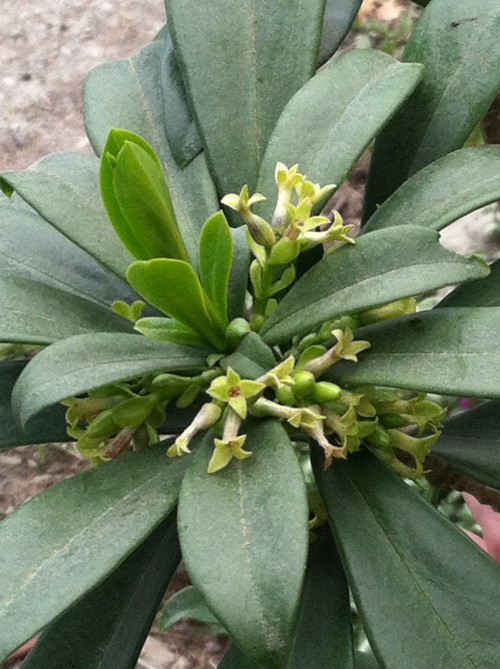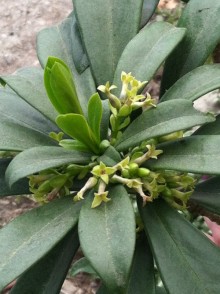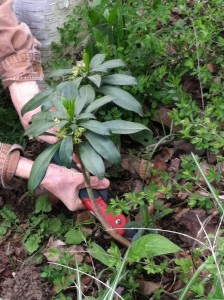— from Kate Yturri, Judy Winer and Gwen Stamm, recent graduates of the WSU Master Gardener’s Course —
 Please look for Spurge Laurel on your property and in the community. It is a shade tolerant shrub, typically 2 to 4 ft. tall, with shiny smooth evergreen leaves that are lighter in color underneath and are alternately arranged in dense spirals near the ends of the branches. The light greenish yellow flowers are clustered at the base of the leaves and bloom between March and May. Fruits are little oval black berries with one seed and are poisonous.
Please look for Spurge Laurel on your property and in the community. It is a shade tolerant shrub, typically 2 to 4 ft. tall, with shiny smooth evergreen leaves that are lighter in color underneath and are alternately arranged in dense spirals near the ends of the branches. The light greenish yellow flowers are clustered at the base of the leaves and bloom between March and May. Fruits are little oval black berries with one seed and are poisonous.
Spurge Laurel has been spotted on all the main islands as well as many of the smaller ones, in forest understories and at private residences. The black berries and sap are toxic to humans, livestock, dogs and cats. The plant is native to Europe and North Africa and is rapidly naturalizing throughout San Juan County, shading out natives and suppressing forest regeneration. It is considered a serious threat to Garry oak woodlands and dry madrone/Douglas fir forests in the San Juan Islands and coastal British Columbia.
The plant reproduces through seeds, often spread by birds and rodents and through production of root sprouts. Spurge Laurel may be confused with English or Portugal laurel, Pieris, azaleas, or immature rhododendrons but may be distinguished by the densely whorled flowers cluster near the top of the stem.
Hand pulling small plants is effective. Wear gloves and protective gear when handling Spurge Laurel due to the toxins in the sap, stem, leaves and fruits. Larger shrubs can be pulled with a weed wench, treated with a selective herbicide or cut below the soil line. Herbicide applied to the cut stump prevents re-sprouting.
Spurge Laurel is a CLASS B Noxious Weed and is designated for control in San Juan County.
**If you are reading theOrcasonian for free, thank your fellow islanders. If you would like to support theOrcasonian CLICK HERE to set your modestly-priced, voluntary subscription. Otherwise, no worries; we’re happy to share with you.**










Thanks. I hope this will be a regular column. Would you please include the botanical name in your articles? It seems to be easier to look up plants by their botanical names.
Wouldn’t white vinegar work as well?
Spirit Eagle